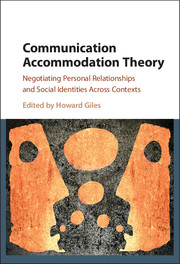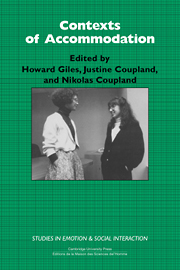Communication Accommodation Theory
Most people modify their ways of speaking, writing, texting, and e-mailing, and so on, according to the people with whom they are communicating. This fascinating book asks why we 'accommodate' to others in this way, and explores the various social consequences arising from it. Communication Accommodation Theory (CAT), revised and elaborated over the past 40 years, has been applied to a wide range of situations, from families to courtrooms, and from media to hospitals, by means of diverse methodologies in many disciplines, and across numerous languages and cultures. Bringing together a team of experts, this book demonstrates how the theory can help us towards a greater understanding of interpersonal communication in a multitude of contexts. Finally, it examines the principles of the theory, identifying a range of avenues along which research can move forward in future.
- A fascinating account of how and why we modify our way of speaking, texting, and e-mailing, and so on, according to the people with whom we are communicating
- An invaluable resource for those already invoking Communication Accommodation Theory in their work, and for those yet to realize its potential
- Furthers our understanding of interpersonal communication, and is of real significance to those studying new applied contexts, from families to courtrooms, and from media to hospitals
Reviews & endorsements
'This long-awaited collection of new perspectives on Communication Accommodation Theory (CAT), edited by Howard Giles, whose name is synonymous with CAT, is most welcome. The chapters contributed by leading international scholars include cutting-edge research on theoretical issues, and both quantitative and qualitative methodology, as well as richly exemplified discussion of intergroup and organizational dimensions. This volume will be embraced with enthusiasm by the many research students and scholars who have found CAT invaluable in enriching their understanding of communication across diverse contexts, cultures and social groups.' Janet Holmes, Emeritus Professor, Victoria University of Wellington
Product details
August 2016Adobe eBook Reader
9781316786505
0 pages
0kg
3 b/w illus. 5 tables
This ISBN is for an eBook version which is distributed on our behalf by a third party.
Table of Contents
- Acknowledgements
- 1. The social origins of CAT Howard Giles
- 2. Theoretical perspectives on interpersonal adjustments in language and communication Jessica Gasiorek
- 3. Accommodative strategies as core of the theory Marko Dragojevic, Jessica Gasiorek and Howard Giles
- 4. Methods of CAT inquiry: quantitative studies Jordan Soliz and Gretchen Bergquist
- 5. The 'dark side' of CAT: nonaccommodation Jessica Gasiorek
- 6. CAT and talk in action Cindy Gallois, Ann Weatherall and Howard Giles
- 7. Intergroup accommodation, social categories, and identities Nicholas A. Palomares, Howard Giles, Jordan Soliz and Cindy Gallois
- 8. Accommodating health Bernadette M. Watson, David G. Hewett and Liz Jones
- 9. CAT on trial Augusto Gnisci, Howard Giles and Jordan Soliz
- 10. CAT integrations and new framework developments Cindy Gallois, Jessica Gasiorek, Howard Giles and Jordan Soliz
- Index.








